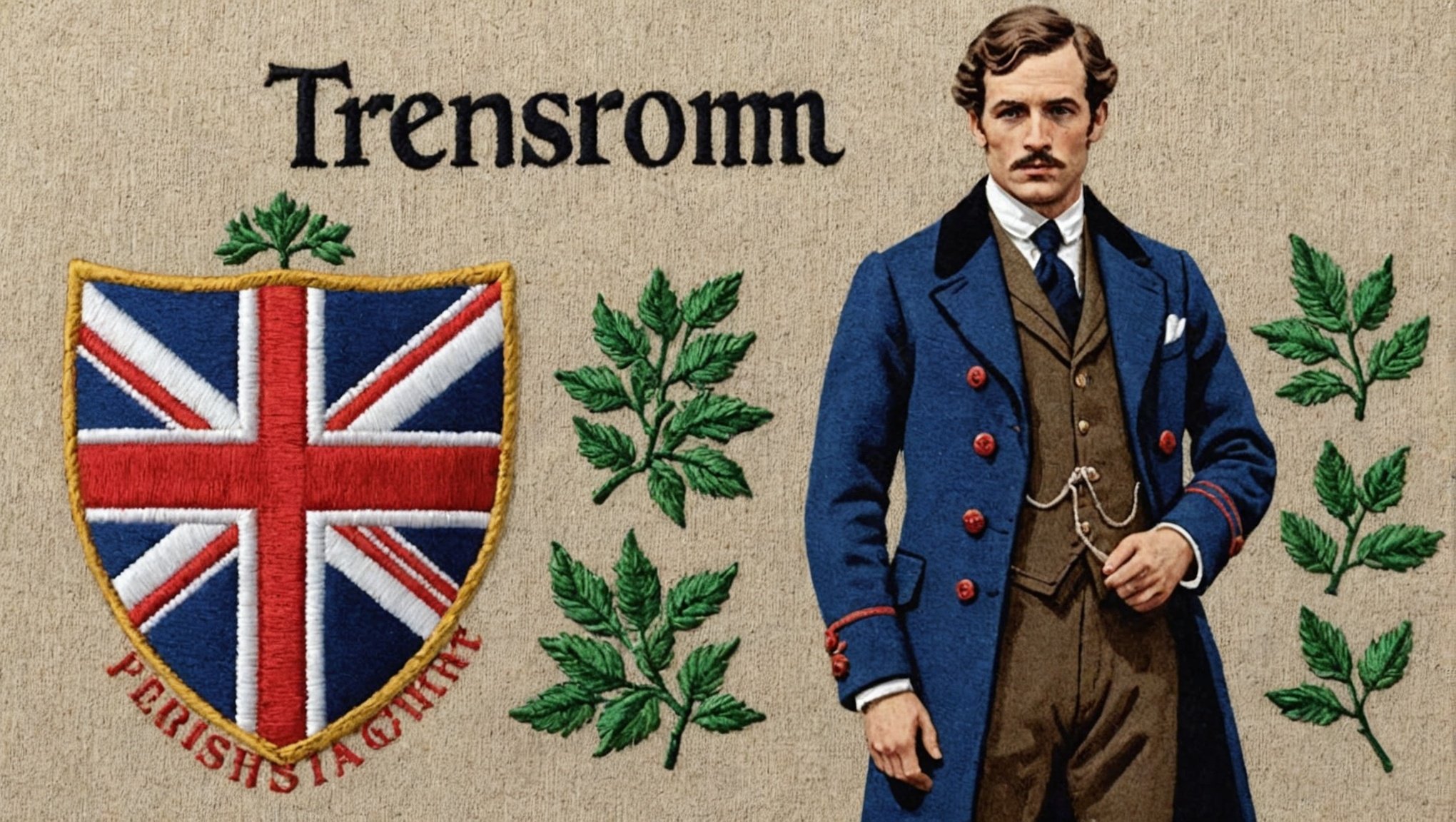Classic British attire boasts timeless elegance, yet it can feel a bit conventional. Thoughtful embroidery breathes new life into traditional garments, allowing for personal expression and creativity. Whether it's a subtle monogram on a blazer or bold motifs on a dress, embroidery adds character and uniqueness to your wardrobe. This guide explores innovative ways to personalize your British fashion, helping you stand out while embracing the charm of classic styles. Discover the endless possibilities awaiting your creativity.
Understanding the Cultural Significance of Embroidery in British Fashion
Exploring the intricate world of embroidery in British fashion reveals a tapestry woven with history, identity, and evolving trends.
Topic to read : Ultimate Guide to Choosing the Finest Fabrics for Custom Hats at UK Horse Racing Events
Historical Context of Embroidery in British Attire
The art of embroidery has long been a cornerstone of British fashion, dating back to the medieval era where it adorned the garments of royalty and the church. This craft was not merely decorative but a symbol of status and power. Historically, embroidery techniques were passed down through generations, preserving cultural heritage and craftsmanship.
Influence of Embroidery on Cultural Identity
Embroidery plays a pivotal role in shaping cultural identity. It reflects the rich tapestry of British society, often incorporating motifs that symbolize regional pride and historical events. The use of embroidery in attire serves as a form of non-verbal communication, expressing personal and communal identities. This cultural significance is evident in traditional costumes and ceremonial garments, where embroidery continues to convey stories and values.
Also read : Mastering the Fedora: Stylish Tips for Achieving a Trendy Look in Bristol
Modern Interpretations and Trends in Embroidery
In contemporary British fashion, embroidery has evolved, merging traditional techniques with modern aesthetics. Designers are reimagining embroidery to create innovative patterns that resonate with today's fashion-forward audiences. This fusion of old and new has led to exciting trends, such as embroidered streetwear and sustainable fashion practices. The versatility of embroidery allows it to adapt to changing tastes while maintaining its cultural roots.
Embroidery remains a vibrant element of British fashion, celebrating the past while embracing the future. Its enduring appeal lies in its ability to connect generations through a shared appreciation of artistry and cultural expression.
Selecting Patterns for Embroidery
Choosing the right embroidery patterns can enhance both traditional and modern British attire.
Types of Embroidery Patterns for Classic British Attire
Embroidery patterns come in a variety of styles, each suitable for different types of classic British attire. Floral patterns are a timeless choice, often seen in traditional garments, reflecting the natural beauty of the British countryside. For a more regal look, geometric designs inspired by historical motifs can add a touch of elegance and sophistication. Meanwhile, Celtic knots offer intricate detail that resonates with British heritage, making them a popular choice for those seeking to honor cultural roots.
Choosing Patterns That Reflect Personal Style
Selecting embroidery patterns that reflect personal style involves considering both aesthetic preferences and the message you wish to convey. If you lean towards a minimalist style, consider simple line patterns that add subtle detail without overwhelming the garment. For a bolder statement, abstract designs can showcase creativity and individuality. It's important to choose patterns that not only complement your wardrobe but also resonate with your personal identity and values.
Resources for Pattern Inspiration
Finding inspiration for embroidery patterns can be an exciting journey. Numerous resources are available to help you discover new designs and techniques. Consider exploring:
- Books: Many books offer a wealth of embroidery patterns, from traditional to modern styles.
- Websites: Online platforms provide a vast array of free and purchasable patterns, catering to all skill levels.
- Workshops: Attending embroidery workshops can offer hands-on experience and inspiration from fellow enthusiasts.
Incorporating these resources into your creative process can lead to the discovery of unique patterns that enhance your embroidery projects.
Choosing the Right Materials and Tools
When embarking on an embroidery project, selecting the appropriate materials and tools is crucial for achieving the desired results.
Overview of Fabrics for British Attire
In British fashion, the choice of fabric can greatly influence the outcome of your embroidery. Linen is a popular option, known for its durability and natural texture, making it ideal for both traditional and modern designs. Cotton, with its smooth surface, is favored for its ease of stitching and versatility. For more luxurious projects, consider silk, which offers a lustrous finish but requires careful handling. Each of these fabrics provides a unique base, enhancing the intricacy and beauty of your embroidery work.
Essential Tools for Embroidery Beginners
Starting with the right tools can make embroidery an enjoyable and rewarding craft. Here are some essentials:
- Embroidery hoops: These maintain fabric tension, ensuring even stitches.
- Needles: Choose sharp needles with varying sizes for different thread thicknesses.
- Scissors: Small, sharp scissors are crucial for precise thread cutting.
These tools are fundamental for beginners, providing the foundation needed to develop your skills and creativity.
Tips for Sourcing High-Quality Materials
Sourcing high-quality materials ensures that your embroidery projects look professional and last longer. Consider the following tips:
- Local craft stores: Offer a wide range of fabrics and tools, allowing you to feel and assess the quality firsthand.
- Online retailers: Provide convenience and often a broader selection, but be sure to check reviews for quality assurance.
- Specialty shops: Focus on embroidery supplies, offering expert advice and unique materials.
By carefully selecting your materials and tools, you can enhance the quality and beauty of your embroidery projects, reflecting both personal style and cultural heritage.
Step-by-Step Guide for Beginners
Embarking on an embroidery journey can be both exciting and rewarding. This guide will help beginners navigate the essential techniques needed to create stunning pieces.
Preparing Your Fabric
Before beginning any embroidery project, proper fabric preparation is crucial.
Start by selecting a fabric that suits your design, such as linen or cotton. To ensure the fabric is ready for embroidery, wash and iron it to remove any wrinkles or impurities. This step is essential as it prevents distortion of your stitches and maintains the integrity of your design. Use an embroidery hoop to keep the fabric taut, which aids in achieving even stitches.
Transferring Your Pattern
Transferring your chosen pattern onto fabric is a key step in the embroidery process.
There are several methods to transfer designs. One popular technique is using a transfer pen to trace the pattern directly onto the fabric. Alternatively, you can use carbon paper for more intricate designs. For beginners, tracing paper is a simple and effective option. Ensure that the pattern is centered and aligned correctly to avoid any misplacement during stitching.
Basic Stitch Techniques
Mastering basic stitch techniques is fundamental for any beginner.
Here are a few essential stitches to get you started:
- Backstitch: Ideal for outlines and creating straight lines.
- Satin stitch: Perfect for filling in shapes with solid color.
- French knot: Adds texture and dimension to your design.
These stitches form the foundation of most embroidery projects. Practice each technique on a scrap piece of fabric to build confidence and precision. As you become more comfortable, experiment with combining different stitches to enhance your designs.
By following these steps, beginners can develop their embroidery skills and create beautiful, personalized pieces.
Creative Ideas for Personalizing Classic British Attire
Explore how to infuse traditional British garments with modern embroidery flair.
Examples of Personalized Classic British Garments
Personalizing classic British attire with embroidery offers a unique way to express individual style while honoring traditional aesthetics. Consider adding a touch of embroidery to a classic tweed jacket. A subtle floral motif on the lapel can transform this timeless piece into a statement of personal style. Similarly, trousers can be customized with geometric embroidery along the side seams, creating an eye-catching detail that remains sophisticated. These enhancements maintain the garment's traditional appeal while introducing a modern twist.
How to Incorporate Embroidery into Various Clothing Items
Incorporating embroidery into different clothing items allows for creative customization. Jackets can be enhanced with intricate designs on the back panel, offering a bold fashion statement. For trousers, consider embroidered cuffs or pockets to add a subtle yet impactful touch. Shirts can feature embroidered collars or cuffs, introducing elegance to everyday wear. This approach to fashion customization enables individuals to tailor their wardrobe to their personal taste, making each piece truly unique.
Tips for Balancing Traditional Style with Modern Embroidery
Balancing traditional style with modern embroidery requires a keen eye for detail and creativity. Here are some tips to achieve this balance:
- Start small: Begin with minimal embroidery accents to test how they complement the garment.
- Choose complementary colors: Select thread colors that enhance the overall look without overpowering the traditional style.
- Mix patterns: Combine classic motifs with contemporary designs for a harmonious blend.
Using these strategies, fashion enthusiasts can personalize their attire while respecting the rich heritage of British fashion. This blend of tradition and innovation not only enhances personal style but also breathes new life into classic garments.
Case Studies: Successful Embroidery Projects
Exploring real-life examples of fashion transformation through embroidery.
Showcasing Individuals or Brands
Embroidery has the power to transform fashion, as demonstrated by various successful projects. Burberry, a renowned British brand, has effectively utilized embroidery to revitalize their classic trench coats. By incorporating intricate patterns along the collars and cuffs, they've managed to blend tradition with modernity, appealing to a broad audience. Similarly, independent designer Sarah Burton has gained acclaim for her unique approach to embroidery on evening wear, adding dimension and storytelling elements to her creations. These case studies highlight how embroidery can elevate garments, offering a fresh perspective on classic designs.
Analysis of Project Outcomes and Wearer Satisfaction
The impact of these embroidery projects extends beyond aesthetics. For Burberry, the embroidered trench coats not only enhanced the visual appeal but also increased customer engagement, as evidenced by a rise in sales. Customers reported a sense of connection to the brand's heritage while enjoying the contemporary twist. In Sarah Burton's case, her clients expressed high satisfaction, noting that the personalized embroidery added a unique and personal touch to their attire, making each piece feel exclusive.
Lessons Learned from Featured Embroidery Projects
These projects offer valuable insights into the effective use of embroidery in fashion. Here are some key lessons:
- Attention to Detail: Precise embroidery techniques can significantly impact the overall quality and appeal of a garment.
- Balancing Tradition and Innovation: Successfully combining classic motifs with modern designs can attract diverse audiences.
- Customer-Centric Design: Understanding the wearer's preferences and incorporating them into the design ensures higher satisfaction and brand loyalty.
These lessons emphasize the importance of thoughtful design and execution in embroidery projects, showcasing its potential to transform and personalize fashion.











